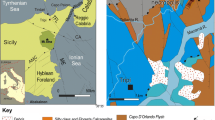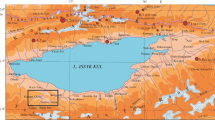Abstract
We study the Byzantine-to-Ummayad (6th–8th century) archaeological site of Umm-El-Qanatir, located 10 km east of the Dead Sea Transform (DST) in northern Israel. The site was damaged by an earthquake-induced landslide, and in this work we use slope stability analysis to constrain the historical seismic acceleration that occurred along the northern segment of the DST. Umm-El-Qanatir archaeological site is located on a slope of a canyon and contains evidence for earthquake-related damage, including fallen columns and walls, horizontal shift of heavy masonry blocks, and complete burial of ceramic pots and farming tools beneath fallen ceilings. A water pool that collected spring water is displaced nearly one meter by the landslide. The artifacts from the village and the spring area indicate that people inhabited the site until the middle of the 8th century. We argue that the destruction, which forced the abandonment of Umm-El-Qanatir together with nearby settlements, was associated with the earthquake of January 18, 749 CE. In order to evaluate the ground acceleration related to the above earthquake, we back-analyze the stability of a failed slope, which cut and displaced the water-pool, using slope stability software (Slope/W). The results show that the slope is statically stable and that high values of horizontal seismic acceleration (>0.3 g) are required to induce slope failure. Subsequently, we use the Newmark displacement method to calculate the earthquake magnitude needed to cause the slope failure as a function of distance from the site. The results (attributed to the 749 CE earthquake) show that a MW > 7.0 earthquake up to 25 km from the site could have induced the studied landslide.









Similar content being viewed by others
References
Ambraseys NN (2005) The seismic activity in Syria and Palestine during the Middle of the 8th century; an amalgamation of historical earthquakes. J Seismol 9(1):115–125. doi:10.1007/s10950-005-7743-2
Amiran DHK, Arieh E, Turcotte T (1994) Earthquakes in Israel and adjacent areas: Macroseismic observations since 100 B.C.E. Isr Explor J 44:260–305
Arias A (1970) A measure of earthquake intensity. In: Hansen RJ (ed) Seismic design for nuclear power plants. Massachusetts Institute of Technology Press, Cambridge, pp 438–483
ASTM (1985) Classification of soils for engineering purposes. In: Annual book of ASTM standards. American Society for Testing and Materials, pp 395–408
Bartov Y, Sneh A, Fleischer L, Arad V, Rosensaft M (2002) Map of potentially active faults in Israel. Geological Survey of Israel report GSI/29/02, Jerusalem
Begin BZ, Steinberg DM, Ichinose GA, Marco S (2005) A 40,000 years unchanging of the seismic regime in the Dead Sea rift. Geology 33(4):257–260. doi:10.1130/G21115.1
Bishop AW (1955) The use of the slip circle in the stability analysis of slopes. Geotechnique 5:7–17
Daëron M, Klinger Y, Tapponnier P, Elias A, Jacques E, Sursock A (2005) Sources of the large AD 1202 and 1759 Near East earthquakes. Geology 33(7):529–532. doi:10.1130/G21352.1
Davis LL, West LR (1975) A preliminary evaluation of the effects of topography on ground motion. Calif Div Mines Geol Bull 196:305–312
Ellenblum R, Marco S, Agnon A, Rockwell T, Boas A (1998) Crusader castle torn apart by earthquake at dawn, 20 May 1202. Geology 26(4):303–306. doi:10.1130/0091-7613(1998)026<0303:CCTABE>2.3.CO;2
Fellenius W (1936) Calculations of the stability of earth dams. Trans second congress of large dams, vol 4, pp 445–463, Washington
Freund R, Zak I, Garfunkel Z (1968) Age and rate of the sinistral movement along the Dead Sea Rift. Nature 220:253–255. doi:10.1038/220253a0
Garfunkel Z (1981) Internal structure of the Dead Sea leaky transform (rift) in relation to plate kinematics. Tectonophysics 80:81–108. doi:10.1016/0040-1951(81)90143-8
Guidoboni E, Comastri A (2005) Catalogue of Earthquakes and Tsunamis in the Mediterranean Area from the 11th to the 15th century. Istituto Nazionale di Geofisica, Bologna, p 1037
Guidoboni E, Comastri A, Traina G (1994) Catalogue of Ancient Earthquakes in the Mediterranean Area up to the 10th century. Istituto Nazionale di Geofisica, Bologna, p 504
Hall JK (1994) Digital shaded-relief map of Israel and environs 1:500,000. Israel Geological Survey
Jibson RW (2007) Regression models for estimating coseismic landslide displacement. Eng Geol 91(2–4):209–218. doi:10.1016/j.enggeo.2007.01.013
Jibson RW, Keefer DK (1993) Analysis of the seismic origin of landslides—examples from the New-Madrid Seismic Zone. Geol Soc Am Bull 105(4):521–536. doi:10.1130/0016-7606(1993)105<0521:AOTSOO>2.3.CO;2
Jibson RW, Harp EL, Michael JA (2000) A method for producing digital probabilistic seismic landslide hazard maps. Eng Geol 58:271–289. doi:10.1016/S0013-7952(00)00039-9
Karcz I (2004) Implications of some early Jewish sources for estimates of earthquake hazard in the Holy Land. Ann Geophys 47(2–3):759–792
Katz O, Crouvi O (2007) The geotechnical effects of long human habitation (2000 < years): Earthquake induced landslide hazard in the city of Zefat, northern Israel. Eng Geol 95(3–4):57–78. doi:10.1016/j.enggeo.2007.07.008
Keefer DK (1984) Landslides caused by earthquakes. Geol Soc Am Bull 95:406–421. doi:10.1130/0016-7606(1984)95<406:LCBE>2.0.CO;2
Keefer DK (2002) Investigating landslides caused by earthquakes—a historical review. Surv Geophys 23(6):473–510. doi:10.1023/A:1021274710840
Kohl H, Watzinger C (1916) Antike Synagogen in Galilaea. J. C. Hinrichs, Leipzig
Marco S (2008) Recognition of earthquake-related damage in archaeological sites: examples from the Dead Sea fault zone. Teconophysics 453:148–156. doi:10.1016/j.tecto.2007.04.011
Marco S, Hartal M, Hazan N, Lev L, Stein M (2003) Archaeology, history, and geology of the A.D. 749 earthquake, Dead Sea Transform. Geology 31(8):665–668. doi:610.1130/G19516.19511
Marco S, Rockwell TK, Heimann A, Frieslander U, Agnon A (2005) Late Holocene slip of the Dead Sea Transform revealed in 3D palaeoseismic trenches on the Jordan Gorge segment. Earth Planet Sci Lett 234(1–2):189–205. doi:10.1016/j.epsl.2005.01.017
Michelson H (1979) The geology and paleogeography of the Golan Heights. In: Tel Aviv University, Tel Aviv, p 163
Newmark NM (1965) Effects of earthquakes on dams and embankments. Geotechnique 15:139–160
Oliphant L (1886) Haifa. In: Dana CA (ed) Life in modern Palestine. W. Blackwood, Edinburgh, p 369
Reches Z, Hoexter DF (1981) Holocene seismic and tectonic activity in the Dead Sea area. Tectonophysics 80:235–254. doi:10.1016/0040-1951(81)90151-7
Sbeinati MR, Darawcheh R, Mouty M (2005) The historical earthquakes of Syria: an analysis of large and moderate earthquakes from 1365 B.C. to 1900 A.D. Ann Geophys 48(3):347–435
Schumacher G (1886) Across the Jordan: being an exploration and survey of part of Hauran and Jaulan. R. Bentley, London, p 342
Segal A, Mlynarczyk J, Burdajewicz M, Schuler M, Eisenberg M (2003) Hippos-Sussita: fourth season of excavations, June–July 2003. In: Zinman Institute of Archaeology, Haifa University, Haifa, p 101
Acknowledgments
We are grateful to all the people who worked in the archeological excavations—Noam Aharoni, Tuvia Ka’atabi, and Hanoch Tal. We thank Mor Kanari and Boaz Gatenio for their assistance in the field. Part of the study was supported by an Israel Science Foundation grant 12/03 to SM.
Author information
Authors and Affiliations
Corresponding author
Rights and permissions
About this article
Cite this article
Wechsler, N., Katz, O., Dray, Y. et al. Estimating location and size of historical earthquake by combining archaeology and geology in Umm-El-Qanatir, Dead Sea Transform. Nat Hazards 50, 27–43 (2009). https://doi.org/10.1007/s11069-008-9315-6
Received:
Accepted:
Published:
Issue Date:
DOI: https://doi.org/10.1007/s11069-008-9315-6




